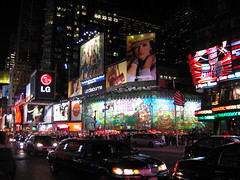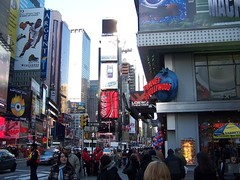South:Milford PlazaCorner (700 8th Ave): Opened in 1929 as the Lincoln Hotel. Houses the Celebrity Deli and Garvey's Irish Pub. Golden Theatre252: The John Golden Theater, completed in 1927, is one of several designed by Herbert J. Krapp on this block--and the best of the bunch. Originally called the Theatre Masque, it was bought in 1937 by producer John Golden, who renamed it after himself. (Earlier, he briefly owned the Royale next door, and renamed it for himself as well.) Tobacco Road opened here; Angel Street played here for years. It's the first theater featured in the film All About Eve. Jacobs Theatre242: Built by Krapp in 1926-27 as the Royale Theatre, where Mae West had her star-making run in Diamond Lil in 1928. For a time it was Columbia Broadcasting's Radio Theater No. 1. It later saw the Broadway bows of The Night of the Iguana, Joseph and the Amazing Technicolor Dreamcoat and Copenhagen. It was renamed for Shubert Organization president Bernard B. Jacobs in 2005. Schoenfeld Theater236: Built as the the Plymouth Theatre in 1917, this was the first of the theaters that Herbert J. Krapp designed for the Shuberts. The Skin of Our Teeth, The Odd Couple, Equus, Dancing at Lughnasa and Passion bowed here. Renamed for Gerald Schoenfeld, longtime chair of the Shubert Organization, in 2005. I guess it beats renaming a historic theater after a car company, but it's still plenty tacky. Booth Theatre222: Designed by Henry B. Herts, built in 1913. Named for Edwin Booth, New York's leading Shakesperean of an earlier era, and the brother of John Wilkes Booth. You Can't Take It With You and Sunday in the Park With George premiered here. |
|
Astor Plaza
Corner (1515 Broadway): Best known as the
location of MTV's studios, this 1969 Kahn & Jacobs
building was allowed to grow to 50 floors because
it added theatrical space--The Minskoff,
named for the skyscraper's developer. (Sunset
Boulevard and The Scarlet Pimpernel had
their debuts here.)
On the ground floor at the corner with Shubert Alley is Junior's, the Theater District incarnation of the Brooklyn standard, famous for its cheesecake. Opened here in 2006. The building replaced its namesake, the Astor Hotel, a well-loved Times Square landmark. Built in 1904 by William Waldorf Astor, the hotel housed such celebrity residents as Toscanini, Will Rogers, Jimmy Durante and Carmen Miranda. It was here, according to Cole Porter, that Mimsie Starr got pinched in the Astor Bar. It was also, on January 23, 1931, the setting of the Beaux Arts Ball, a costume party for architects including Ely Jacques Kahn and William Van Alen, who came dressed as his Chrysler Building; missing this party was one of the reasons that the lady was a tramp. |
W
|
North:269: Frankie & Johnnie's Steakhouse opened here as a speakeasy in 1926; Babe Ruth and Al Jolson are said to have been regulars. 263: Sam's, a rustic restaurant popular with chorus girls and boys. 259: Puleo's Too, Italian 251: Was Columbia Broadcasting's Radio Theater No. 2. Now Off-Broadway Theater Information Center. Imperial Theatre249: This 1923 theater's interior was designed by Krapp. It saw the launches of Annie Get Your Gun, Gypsy, Oliver!, Fiddler on the Roof, Pippin and Les Miserables. Music Box Theatre239: Irving Berlin had this Federal Revival theater built in 1920, to a C. Howard Crane and E. George Kiehler design, for his Music Box Revue of 1921. It was also home to The Man Who Came to Dinner, Dinner at Eight, Of Thee I Sing, Of Mice and Men and Bus Stop. Dear Evan Hansen played here from 2016 until 2022. 227: Was the Piccadilly Hotel in 1939. 217: Site of the Morosco Theatre, designed by Herbert J. Krapp in 1917 and named by the Shuberts for manager Oliver Morosco, who helped them break the Theatrical Syndicate monopoly. Cat on a Hot Tin Roof opened here in 1955, Blithe Spirit in 1941. Demolished 1982 for the Marriott. 209: Site of the
Bijou Theatre,
a French Renaissance house designed by Krapp for the
Shuberts in 1917.
It went back and forth between legitimate theater
and movies. As the former, Life With Father
and Eugene O'Neill's A Moon for the Misbegotten
both debuted here; the film The Red Shoes played
here for more than two years on its first run. In 1965,
it became the
Toho Cinema, which played Japanese movies
ranging from Kurosawa to Matango, Fungus of Death.
Demolished 1982.
New York Marriott Marquis
Corner (1535 Broadway): When this glitzy
mammoth was built in 1981-85--the first major new
hotel in Times Square in 75 years--it destroyed
five classic theaters: the
Astor,
Bijou,
Gaiety,
Morosco and the old
Helen Hayes. (It did add one
new one--the
Marquis.) This wanton destruction
led to a wave of landmarking in the Theater District.
The hotel's design is by John Portman, noted for similar hotels around the country. The atrium/elevator column is pretty spectacular, I have to admit. The facade of the hotel features a huge electronic sign for Bank of America, and an enormous ad for Kodak. In the movie True Lies, Arnold Schwarzenegger rides a horse on this building and almost falls off the edge. Corner (1537 Broadway): The Astor Theater, once on this corner, was in 1948 the site of Babe Ruth's final public appearance, to attend the premiere of The Babe Ruth Story. |




